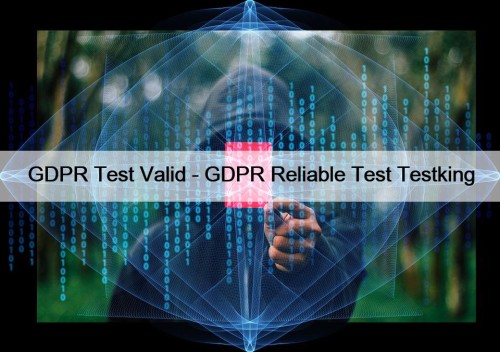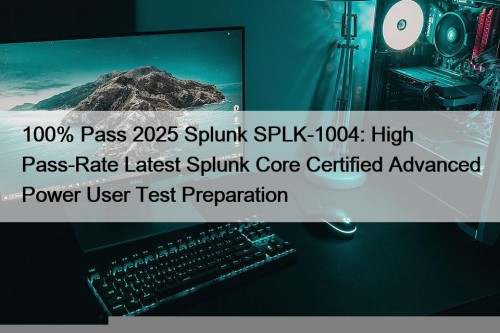Most Popular
 Pass Guaranteed 2025 Professional WGU Information-Technology-Management: WGU Information Technology Management QGC1 Testdump
Pass Guaranteed 2025 Professional WGU Information-Technology-Management: WGU Information Technology Management QGC1 Testdump
Therefore, if you have struggled for months to pass WGU ...
 GDPR Test Valid - GDPR Reliable Test Testking
GDPR Test Valid - GDPR Reliable Test Testking
Did you have bad purchase experience that after your payment ...
 100% Pass 2025 Splunk SPLK-1004: High Pass-Rate Latest Splunk Core Certified Advanced Power User Test Preparation
100% Pass 2025 Splunk SPLK-1004: High Pass-Rate Latest Splunk Core Certified Advanced Power User Test Preparation
DOWNLOAD the newest ExamsTorrent SPLK-1004 PDF dumps from Cloud Storage ...



MLS-C01 Training Material | MLS-C01 Reliable Test Objectives

BONUS!!! Download part of PDFBraindumps MLS-C01 dumps for free: https://drive.google.com/open?id=1e9HswJtkyCEka3aJgSf6X6EF4vjjvm8b
We know that tenet from the bottom of our heart, so all parts of service are made due to your interests. You are entitled to have full money back if you fail the exam even after getting our MLS-C01 test prep. Our staff will help you with genial attitude. We esteem your variant choices so all these versions of MLS-C01 Study Materials are made for your individual preference and inclination. Please get to know our MLS-C01 study materials as follows.
Amazon AWS-Certified-Machine-Learning-Specialty (AWS Certified Machine Learning - Specialty) exam is a certification program designed for professionals who want to demonstrate their expertise in the field of machine learning. MLS-C01 Exam is intended to validate the knowledge and skills of candidates in building, training, and deploying machine learning models on the Amazon Web Services (AWS) platform.
Difficulty in preparing for AWS Certified Machine Learning Specialty Exam
In addition to our comprehensive study guide, we also offer exam dumps of certified AWS Certified Machine Learning Specialty, if you want a quick and exam-oriented preparation. Any information in this AWS Certified Machine Learning Specialty exam dumps is valuable.
Questions and answers from the AWS Certified Machine Learning Specialty include important topics from the AWS Certified Machine Learning Specialty Certification Program and provides easy-to-learn information for easy access.
The AWS Certified Machine Learning - Specialty (MLS-C01) examination is intended for individuals who perform a development or data science role. This exam validates an examinee's ability to build, train, tune, and deploy machine learning (ML) models using the AWS Cloud.
Candidate must have 1-2 years of hands-on experience developing, architecting, or running ML/deeplearning workloads on the AWS Cloud, along with:
- Experience performing basic hyperparameter optimization
- The ability to follow model-training best practices
- Experience with ML and deep learning frameworks
- The ability to follow deployment and operational best practices
- The ability to express the intuition behind basic ML algorithms
Candidates for the AWS Certified Machine Learning Specialty should have a thorough knowledge and understanding of all the questions and answers of the AWS Certified Machine Learning Specialty in our practice exam and exam dumps.
>> MLS-C01 Training Material <<
MLS-C01 Reliable Test Objectives & Reliable MLS-C01 Learning Materials
Providing our customers with up to 1 year of free Amazon MLS-C01 questions updates is also our offer. These Amazon MLS-C01 free dumps updates will help you prepare according to the latest MLS-C01 test syllabus in case of changes. 24/7 customer support is available at PDFBraindumps to assist users of the MLS-C01 Exam Questions through the journey. Above all, PDFBraindumps also offers a full refund guarantee (terms and conditions apply) to our customers. Don't miss these amazing offers. Download AWS Certified Machine Learning - Specialty (MLS-C01) actual exam Dumps today!
Amazon AWS Certified Machine Learning - Specialty Sample Questions (Q255-Q260):
NEW QUESTION # 255
An office security agency conducted a successful pilot using 100 cameras installed at key locations within the main office. Images from the cameras were uploaded to Amazon S3 and tagged using Amazon Rekognition, and the results were stored in Amazon ES. The agency is now looking to expand the pilot into a full production system using thousands of video cameras in its office locations globally. The goal is to identify activities performed by non-employees in real time.
Which solution should the agency consider?
- A. Use a proxy server at each local office and for each camera, and stream the RTSP feed to a unique Amazon Kinesis Video Streams video stream. On each stream, use Amazon Rekognition Video and create a stream processor to detect faces from a collection of known employees, and alert when non-employees are detected.
- B. Install AWS DeepLens cameras and use the DeepLens_Kinesis_Video module to stream video to Amazon Kinesis Video Streams for each camera. On each stream, run an AWS Lambda function to capture image fragments and then call Amazon Rekognition Image to detect faces from a collection of known employees, and alert when non-employees are detected.
- C. Use a proxy server at each local office and for each camera, and stream the RTSP feed to a unique Amazon Kinesis Video Streams video stream. On each stream, use Amazon Rekognition Image to detect faces from a collection of known employees and alert when non-employees are detected.
- D. Install AWS DeepLens cameras and use the DeepLens_Kinesis_Video module to stream video to Amazon Kinesis Video Streams for each camera. On each stream, use Amazon Rekognition Video and create a stream processor to detect faces from a collection on each stream, and alert when nonemployees are detected.
Answer: A
Explanation:
The solution that the agency should consider is to use a proxy server at each local office and for each camera, and stream the RTSP feed to a unique Amazon Kinesis Video Streams video stream. On each stream, use Amazon Rekognition Video and create a stream processor to detect faces from a collection of known employees, and alert when non-employees are detected.
This solution has the following advantages:
It can handle thousands of video cameras in real time, as Amazon Kinesis Video Streams can scale elastically to support any number of producers and consumers1.
It can leverage the Amazon Rekognition Video API, which is designed and optimized for video analysis, and can detect faces in challenging conditions such as low lighting, occlusions, and different poses2.
It can use a stream processor, which is a feature of Amazon Rekognition Video that allows you to create a persistent application that analyzes streaming video and stores the results in a Kinesis data stream3. The stream processor can compare the detected faces with a collection of known employees, which is a container for persisting faces that you want to search for in the input video stream4. The stream processor can also send notifications to Amazon Simple Notification Service (Amazon SNS) when non-employees are detected, which can trigger downstream actions such as sending alerts or storing the events in Amazon Elasticsearch Service (Amazon ES)3.
References:
1: What Is Amazon Kinesis Video Streams? - Amazon Kinesis Video Streams
2: Detecting and Analyzing Faces - Amazon Rekognition
3: Using Amazon Rekognition Video Stream Processor - Amazon Rekognition
4: Working with Stored Faces - Amazon Rekognition
NEW QUESTION # 256
A real estate company wants to create a machine learning model for predicting housing prices based on a historical dataset. The dataset contains 32 features.
Which model will meet the business requirement?
- A. K-means
- B. Linear regression
- C. Logistic regression
- D. Principal component analysis (PCA)
Answer: B
Explanation:
The best model for predicting housing prices based on a historical dataset with 32 features is linear regression. Linear regression is a supervised learning algorithm that fits a linear relationship between a dependent variable (housing price) and one or more independent variables (features). Linear regression can handle multiple features and output a continuous value for the housing price. Linear regression can also return the coefficients of the features, which indicate how each feature affects the housing price. Linear regression is suitable for this problem because the outcome of interest is numerical and continuous, and the model needs to capture the linear relationship between the features and the outcome.
References:
* AWS Machine Learning Specialty Exam Guide
* AWS Machine Learning Training - Regression vs Classification in Machine Learning
* AWS Machine Learning Training - Linear Regression with Amazon SageMaker
NEW QUESTION # 257
A Data Scientist needs to create a serverless ingestion and analytics solution for high-velocity, real-time streaming data.
The ingestion process must buffer and convert incoming records from JSON to a query-optimized, columnar format without data loss. The output datastore must be highly available, and Analysts must be able to run SQL queries against the data and connect to existing business intelligence dashboards.
Which solution should the Data Scientist build to satisfy the requirements?
- A. Create a schema in the AWS Glue Data Catalog of the incoming data format. Use an Amazon Kinesis Data Firehose delivery stream to stream the data and transform the data to Apache Parquet or ORC format using the AWS Glue Data Catalog before delivering to Amazon S3. Have the Analysts query the data directly from Amazon S3 using Amazon Athena, and connect to Bl tools using the Athena Java Database Connectivity (JDBC) connector.
- B. Write each JSON record to a staging location in Amazon S3. Use the S3 Put event to trigger an AWS Lambda function that transforms the data into Apache Parquet or ORC format and writes the data to a processed data location in Amazon S3. Have the Analysts query the data directly from Amazon S3 using Amazon Athena, and connect to Bl tools using the Athena Java Database Connectivity (JDBC) connector.
- C. Write each JSON record to a staging location in Amazon S3. Use the S3 Put event to trigger an AWS Lambda function that transforms the data into Apache Parquet or ORC format and inserts it into an Amazon RDS PostgreSQL database. Have the Analysts query and run dashboards from the RDS database.
- D. Use Amazon Kinesis Data Analytics to ingest the streaming data and perform real-time SQL queries to convert the records to Apache Parquet before delivering to Amazon S3. Have the Analysts query the data directly from Amazon S3 using Amazon Athena and connect to Bl tools using the Athena Java Database Connectivity (JDBC) connector.
Answer: A
Explanation:
To create a serverless ingestion and analytics solution for high-velocity, real-time streaming data, the Data Scientist should use the following AWS services:
AWS Glue Data Catalog: This is a managed service that acts as a central metadata repository for data assets across AWS and on-premises data sources. The Data Scientist can use AWS Glue Data Catalog to create a schema of the incoming data format, which defines the structure, format, and data types of the JSON records. The schema can be used by other AWS services to understand and process the data1.
Amazon Kinesis Data Firehose: This is a fully managed service that delivers real-time streaming data to destinations such as Amazon S3, Amazon Redshift, Amazon Elasticsearch Service, and Splunk. The Data Scientist can use Amazon Kinesis Data Firehose to stream the data from the source and transform the data to a query-optimized, columnar format such as Apache Parquet or ORC using the AWS Glue Data Catalog before delivering to Amazon S3. This enables efficient compression, partitioning, and fast analytics on the data2.
Amazon S3: This is an object storage service that offers high durability, availability, and scalability. The Data Scientist can use Amazon S3 as the output datastore for the transformed data, which can be organized into buckets and prefixes according to the desired partitioning scheme. Amazon S3 also integrates with other AWS services such as Amazon Athena, Amazon EMR, and Amazon Redshift Spectrum for analytics3.
Amazon Athena: This is a serverless interactive query service that allows users to analyze data in Amazon S3 using standard SQL. The Data Scientist can use Amazon Athena to run SQL queries against the data in Amazon S3 and connect to existing business intelligence dashboards using the Athena Java Database Connectivity (JDBC) connector. Amazon Athena leverages the AWS Glue Data Catalog to access the schema information and supports formats such as Parquet and ORC for fast and cost-effective queries4.
References:
1: What Is the AWS Glue Data Catalog? - AWS Glue
2: What Is Amazon Kinesis Data Firehose? - Amazon Kinesis Data Firehose
3: What Is Amazon S3? - Amazon Simple Storage Service
4: What Is Amazon Athena? - Amazon Athena
NEW QUESTION # 258
A retail company is ingesting purchasing records from its network of 20,000 stores to Amazon S3 by using Amazon Kinesis Data Firehose. The company uses a small, server-based application in each store to send the data to AWS over the internet. The company uses this data to train a machine learning model that is retrained each day. The company's data science team has identified existing attributes on these records that could be combined to create an improved model.
Which change will create the required transformed records with the LEAST operational overhead?
- A. Create an AWS Lambda function that can transform the incoming records. Enable data transformation on the ingestion Kinesis Data Firehose delivery stream. Use the Lambda function as the invocation target.
- B. Deploy an Amazon EMR cluster that runs Apache Spark and includes the transformation logic. Use Amazon EventBridge (Amazon CloudWatch Events) to schedule an AWS Lambda function to launch the cluster each day and transform the records that accumulate in Amazon S3. Deliver the transformed records to Amazon S3.
- C. Deploy an Amazon S3 File Gateway in the stores. Update the in-store software to deliver data to the S3 File Gateway. Use a scheduled daily AWS Glue job to transform the data that the S3 File Gateway delivers to Amazon S3.
- D. Launch a fleet of Amazon EC2 instances that include the transformation logic. Configure the EC2 instances with a daily cron job to transform the records that accumulate in Amazon S3. Deliver the transformed records to Amazon S3.
Answer: A
Explanation:
The solution A will create the required transformed records with the least operational overhead because it uses AWS Lambda and Amazon Kinesis Data Firehose, which are fully managed services that can provide the desired functionality. The solution A involves the following steps:
Create an AWS Lambda function that can transform the incoming records. AWS Lambda is a service that can run code without provisioning or managing servers. AWS Lambda can execute the transformation logic on the purchasing records and add the new attributes to the records1.
Enable data transformation on the ingestion Kinesis Data Firehose delivery stream. Use the Lambda function as the invocation target. Amazon Kinesis Data Firehose is a service that can capture, transform, and load streaming data into AWS data stores. Amazon Kinesis Data Firehose can enable data transformation and invoke the Lambda function to process the incoming records before delivering them to Amazon S3. This can reduce the operational overhead of managing the transformation process and the data storage2.
The other options are not suitable because:
Option B: Deploying an Amazon EMR cluster that runs Apache Spark and includes the transformation logic, using Amazon EventBridge (Amazon CloudWatch Events) to schedule an AWS Lambda function to launch the cluster each day and transform the records that accumulate in Amazon S3, and delivering the transformed records to Amazon S3 will incur more operational overhead than using AWS Lambda and Amazon Kinesis Data Firehose. The company will have to manage the Amazon EMR cluster, the Apache Spark application, the AWS Lambda function, and the Amazon EventBridge rule. Moreover, this solution will introduce a delay in the transformation process, as it will run only once a day3.
Option C: Deploying an Amazon S3 File Gateway in the stores, updating the in-store software to deliver data to the S3 File Gateway, and using a scheduled daily AWS Glue job to transform the data that the S3 File Gateway delivers to Amazon S3 will incur more operational overhead than using AWS Lambda and Amazon Kinesis Data Firehose. The company will have to manage the S3 File Gateway, the in-store software, and the AWS Glue job. Moreover, this solution will introduce a delay in the transformation process, as it will run only once a day4.
Option D: Launching a fleet of Amazon EC2 instances that include the transformation logic, configuring the EC2 instances with a daily cron job to transform the records that accumulate in Amazon S3, and delivering the transformed records to Amazon S3 will incur more operational overhead than using AWS Lambda and Amazon Kinesis Data Firehose. The company will have to manage the EC2 instances, the transformation code, and the cron job. Moreover, this solution will introduce a delay in the transformation process, as it will run only once a day5.
References:
1: AWS Lambda
2: Amazon Kinesis Data Firehose
3: Amazon EMR
4: Amazon S3 File Gateway
5: Amazon EC2
NEW QUESTION # 259
A company's Machine Learning Specialist needs to improve the training speed of a time-series forecasting model using TensorFlow. The training is currently implemented on a single-GPU machine and takes approximately 23 hours to complete. The training needs to be run daily.
The model accuracy js acceptable, but the company anticipates a continuous increase in the size of the training data and a need to update the model on an hourly, rather than a daily, basis. The company also wants to minimize coding effort and infrastructure changes What should the Machine Learning Specialist do to the training solution to allow it to scale for future demand?
- A. Do not change the TensorFlow code. Change the machine to one with a more powerful GPU to speed up the training.
- B. Move the training to Amazon EMR and distribute the workload to as many machines as needed to achieve the business goals.
- C. Change the TensorFlow code to implement a Horovod distributed framework supported by Amazon SageMaker. Parallelize the training to as many machines as needed to achieve the business goals.
- D. Switch to using a built-in AWS SageMaker DeepAR model. Parallelize the training to as many machines as needed to achieve the business goals.
Answer: C
Explanation:
To improve the training speed of a time-series forecasting model using TensorFlow, the Machine Learning Specialist should change the TensorFlow code to implement a Horovod distributed framework supported by Amazon SageMaker. Horovod is a free and open-source software framework for distributed deep learning training using TensorFlow, Keras, PyTorch, and Apache MXNet1. Horovod can scale up to hundreds of GPUs with upwards of 90% scaling efficiency2. Horovod is easy to use, as it requires only a few lines of Python code to modify an existing training script2. Horovod is also portable, as it runs the same for TensorFlow, Keras, PyTorch, and MXNet; on premise, in the cloud, and on Apache Spark2.
Amazon SageMaker is a fully managed service that provides every developer and data scientist with the ability to build, train, and deploy machine learning models quickly3. Amazon SageMaker supports Horovod as a built-in distributed training framework, which means that the Machine Learning Specialist does not need to install or configure Horovod separately4. Amazon SageMaker also provides a number of features and tools to simplify and optimize the distributed training process, such as automatic scaling, debugging, profiling, and monitoring4. By using Amazon SageMaker, the Machine Learning Specialist can parallelize the training to as many machines as needed to achieve the business goals, while minimizing coding effort and infrastructure changes.
References:
1: Horovod (machine learning) - Wikipedia
2: Home - Horovod
3: Amazon SageMaker - Machine Learning Service - AWS
4: Use Horovod with Amazon SageMaker - Amazon SageMaker
NEW QUESTION # 260
......
Many candidates find the Amazon MLS-C01 exam preparation difficult. They often buy expensive study courses to start their AWS Certified Machine Learning - Specialty (MLS-C01) certification exam preparation. However, spending a huge amount on such resources is difficult for many Amazon exam applicants. The latest Amazon MLS-C01 Exam Dumps are the right option for you to prepare for the MLS-C01 certification test at home. PDFBraindumps has launched the MLS-C01 exam dumps with the collaboration of world-renowned professionals.
MLS-C01 Reliable Test Objectives: https://www.pdfbraindumps.com/MLS-C01_valid-braindumps.html
- Guaranteed MLS-C01 Questions Answers 🔊 MLS-C01 Valid Test Fee 🐓 Valid Test MLS-C01 Vce Free 🍄 Go to website { www.vceengine.com } open and search for 「 MLS-C01 」 to download for free 📉Guaranteed MLS-C01 Questions Answers
- Latest MLS-C01 Dumps 🌶 Cert MLS-C01 Guide 🎧 Valid Test MLS-C01 Vce Free 🧹 Search for ✔ MLS-C01 ️✔️ on [ www.pdfvce.com ] immediately to obtain a free download ⛅MLS-C01 New Questions
- MLS-C01 Valid Test Fee ♿ Latest MLS-C01 Exam Fee 😙 Actual MLS-C01 Test 🔏 Search on [ www.pass4leader.com ] for { MLS-C01 } to obtain exam materials for free download 🔹MLS-C01 Hot Spot Questions
- MLS-C01 Exam Braindumps: AWS Certified Machine Learning - Specialty -amp; MLS-C01 Actual Test Questions 👷 Search for ▶ MLS-C01 ◀ on { www.pdfvce.com } immediately to obtain a free download ⏺Valid Study MLS-C01 Questions
- Valid MLS-C01 Mock Test 🍭 Actual MLS-C01 Test 💡 Reliable MLS-C01 Test Preparation 🤫 Immediately open ⇛ www.exams4collection.com ⇚ and search for ➽ MLS-C01 🢪 to obtain a free download ⏯MLS-C01 Hot Spot Questions
- MLS-C01 Training Material Updated Questions Pool Only at Pdfvce 😐 Download ➤ MLS-C01 ⮘ for free by simply searching on ➡ www.pdfvce.com ️⬅️ 🍻MLS-C01 Valid Cram Materials
- MLS-C01 Training Material - Amazon AWS Certified Machine Learning - Specialty Realistic Training Material Pass Guaranteed 🌷 Open ▛ www.dumpsquestion.com ▟ enter ➽ MLS-C01 🢪 and obtain a free download 👕Vce MLS-C01 Format
- Amazon MLS-C01 Pdf Questions - Outstanding Practice To your AWS Certified Machine Learning - Specialty Exam 💄 Download ➡ MLS-C01 ️⬅️ for free by simply searching on ( www.pdfvce.com ) 🌽Practice MLS-C01 Exam Pdf
- 100% Pass MLS-C01 - AWS Certified Machine Learning - Specialty –High Pass-Rate Training Material 🎥 Search for ➠ MLS-C01 🠰 and download it for free on ✔ www.lead1pass.com ️✔️ website 🐥Valid MLS-C01 Study Guide
- MLS-C01 Hot Spot Questions ⏩ MLS-C01 New Questions 👠 Valid Study MLS-C01 Questions 🗾 「 www.pdfvce.com 」 is best website to obtain ✔ MLS-C01 ️✔️ for free download 👙Cert MLS-C01 Guide
- Guaranteed MLS-C01 Questions Answers 💡 Cert MLS-C01 Guide 🦟 Latest MLS-C01 Exam Fee 🟧 Open 《 www.prep4pass.com 》 enter ➡ MLS-C01 ️⬅️ and obtain a free download 🥚Reliable MLS-C01 Test Preparation
- MLS-C01 Exam Questions
- brainboost.ashiksays.com kursusaja.online www.wiwxw.com zc2.xunyi.icu lms.ytguider.com boldstarschool.com.ng activetopik.com www.zzhan.com.cn frearn.com ufromnowon.com
BONUS!!! Download part of PDFBraindumps MLS-C01 dumps for free: https://drive.google.com/open?id=1e9HswJtkyCEka3aJgSf6X6EF4vjjvm8b
Tags: MLS-C01 Training Material, MLS-C01 Reliable Test Objectives, Reliable MLS-C01 Learning Materials, MLS-C01 Dump, MLS-C01 Vce Free